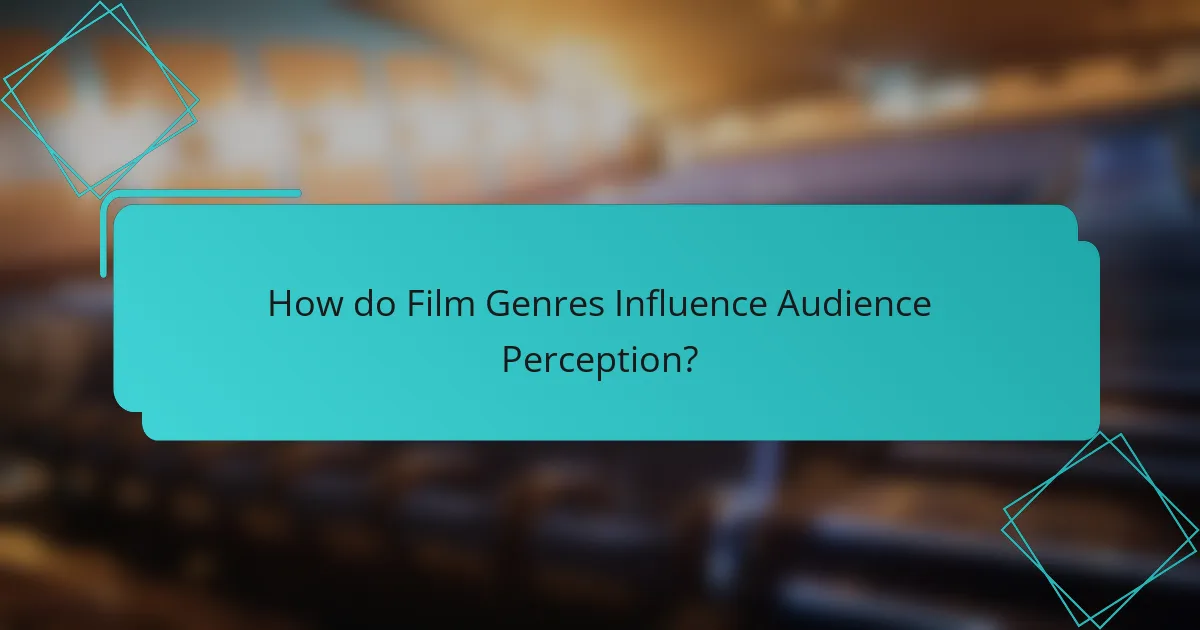Film genres are defined categories that characterize the style, content, and narrative structure of films, guiding audience expectations and engagement. Major genres include drama, comedy, action, horror, science fiction, fantasy, romance, and documentary, each with unique conventions that shape storytelling. The article examines the defining characteristics of these genres, their evolution over time, and their impact on audience perception and marketing strategies. It highlights how familiarity with genres enhances viewer satisfaction and engagement, as well as the cultural associations they create, influencing how narratives and characters are perceived.

What are Film Genres and Their Importance?
Film genres are categories that define the style, content, and narrative structure of films. They help audiences identify what to expect from a film. Common genres include drama, comedy, horror, and action. Each genre has specific conventions and tropes that guide storytelling. For example, horror films often use suspense and fear to engage viewers. Genres also influence marketing strategies and audience targeting. According to research from the University of Southern California, understanding genres can enhance audience satisfaction. This knowledge allows filmmakers to create tailored experiences that resonate with viewers.
How have film genres evolved over time?
Film genres have evolved significantly over time, reflecting changes in culture, technology, and audience preferences. Early cinema primarily featured silent films and simple narratives. The introduction of sound in the late 1920s led to the rise of musicals and dialogue-driven stories.
In the 1930s and 1940s, genres like film noir and screwball comedy emerged, showcasing complex characters and innovative storytelling. The 1950s and 1960s saw the popularity of science fiction and horror, influenced by societal fears and technological advancements.
The 1970s marked the rise of blockbuster films and the action genre, exemplified by titles like “Jaws” and “Star Wars.” The 1980s and 1990s introduced a blend of genres, such as romantic comedies and action-adventure films.
In the 21st century, genres continue to blend, with films often combining elements from multiple categories. Streaming services have further diversified genre offerings, allowing for niche genres to thrive.
Overall, the evolution of film genres reflects broader societal changes and technological innovations, shaping how stories are told and consumed.
What historical events influenced the development of film genres?
The development of film genres has been significantly influenced by various historical events. The rise of World War I led to the creation of war films, reflecting societal trauma. The Great Depression resulted in the popularity of musicals and comedies, offering escapism. World War II brought about film noir, characterized by themes of moral ambiguity and existential dread. The civil rights movement in the 1960s inspired the emergence of socially conscious films, addressing race and equality. The technological advancements in the 1980s, such as CGI, transformed science fiction and action genres. The fall of the Berlin Wall in 1989 led to a surge in international cinema, diversifying genre narratives. Each of these events shaped the thematic and stylistic evolution of film genres throughout history.
How do cultural shifts impact film genre evolution?
Cultural shifts significantly influence film genre evolution by altering audience preferences and societal norms. Changes in social attitudes can lead to the emergence of new genres or the transformation of existing ones. For example, the rise of feminism in the 1960s and 1970s contributed to the development of the feminist film genre. Films began to reflect women’s experiences and challenges, shifting narratives away from traditional male-centric stories.
Additionally, technological advancements can drive genre evolution. The introduction of CGI in the 1990s allowed for the creation of new sci-fi and fantasy genres, expanding storytelling possibilities. Historical events also play a crucial role; post-9/11 films often reflect themes of terrorism and national security, reshaping action and thriller genres.
Moreover, cultural diversity has led to the globalization of film genres. International influences have resulted in hybrid genres that blend elements from different cultures. For instance, the incorporation of Asian martial arts in Hollywood action films has created a fusion genre that appeals to wider audiences.
Overall, cultural shifts reshape film genres by influencing themes, narrative styles, and audience engagement, reflecting the evolving societal landscape.
What are the defining characteristics of film genres?
Film genres are defined by specific characteristics that categorize films based on their narrative elements, themes, and stylistic choices. These characteristics include plot structure, character archetypes, and emotional tone. For example, horror films often utilize suspense and fear, while comedies focus on humor and light-hearted situations. Additionally, genres can be identified by their visual style and sound design, which contribute to the overall atmosphere of the film. Historical context also plays a role, as genres evolve over time influenced by cultural trends and audience expectations. The classification of genres aids in marketing and audience engagement, helping viewers select films that align with their preferences.
How do themes and motifs differentiate film genres?
Themes and motifs serve as key differentiators between film genres. Themes represent the overarching ideas or messages conveyed in a film, such as love, conflict, or redemption. For instance, romantic comedies often explore themes of love and relationships. Motifs are recurring elements that reinforce these themes, such as specific visual symbols or phrases. In horror films, motifs like darkness or isolation enhance the theme of fear. The combination of unique themes and motifs helps to categorize films into genres. For example, action films typically have themes of heroism and justice, complemented by motifs like high-speed chases or explosive sequences. This structured approach enables audiences to identify and anticipate the style and content of a film based on its genre.
What role do narrative structures play in genre classification?
Narrative structures are fundamental to genre classification in film. They provide a framework that guides storytelling conventions within specific genres. For example, a linear narrative structure is often associated with drama, while non-linear structures are common in thrillers and science fiction. These structures influence audience expectations and emotional engagement. Genres utilize specific narrative elements, such as character arcs and plot progression, which help categorize films. Research indicates that audiences rely on familiar narrative structures to identify genres quickly. This classification aids in marketing and distribution strategies within the film industry. Thus, narrative structures play a crucial role in defining and differentiating film genres.

What are the Major Film Genres?
The major film genres include drama, comedy, action, horror, science fiction, fantasy, romance, and documentary. Each genre has distinct characteristics that define its storytelling style. Drama focuses on emotional narratives and character development. Comedy aims to entertain and provoke laughter through humor. Action features high-energy sequences with physical feats and stunts. Horror seeks to elicit fear and suspense from the audience. Science fiction explores futuristic concepts and advanced technology. Fantasy incorporates magical elements and imaginary worlds. Romance centers on love stories and relationships. Documentary presents factual content, often exploring real-life events or issues. These genres have evolved over time, influencing and reflecting societal trends and cultural narratives.
How do we categorize film genres?
Film genres are categorized based on shared characteristics and thematic elements. Common categories include action, drama, comedy, horror, and romance. Each genre has distinct attributes that define its narrative style and audience appeal. For example, action films often feature high-stakes conflict and physical feats. In contrast, dramas focus on character development and emotional narratives.
The categorization helps audiences select films that match their preferences. It also aids filmmakers in targeting specific demographics. Historical context shows that genres evolve over time, reflecting societal changes. For instance, the rise of superhero films in the 2000s aligns with increasing interest in comic book adaptations.
Film scholars often refer to these categories in academic discussions. They analyze how genres influence storytelling techniques and audience expectations. The classification of film genres is essential for understanding cinematic language and cultural impact.
What are the primary genres in cinema today?
The primary genres in cinema today include drama, comedy, action, horror, science fiction, and romance. Drama focuses on emotional narratives and character development. Comedy aims to entertain through humor and lighthearted situations. Action features high-energy sequences, often with physical stunts and chases. Horror seeks to evoke fear and suspense through thrilling narratives. Science fiction explores futuristic concepts and technologies. Romance centers around love stories and relationships. These genres reflect audience preferences and cultural trends.
What sub-genres exist within major film categories?
Action films include sub-genres like superhero, martial arts, and disaster. Superhero films focus on characters with superhuman abilities. Martial arts films highlight combat techniques and choreography. Disaster films revolve around catastrophic events and survival.
Comedy films feature sub-genres such as romantic comedy, dark comedy, and slapstick. Romantic comedies center on love and relationships with humor. Dark comedies tackle serious themes with a humorous twist. Slapstick emphasizes physical humor and exaggerated situations.
Drama films encompass sub-genres like historical drama, crime drama, and coming-of-age. Historical dramas depict significant past events and figures. Crime dramas explore criminal activities and moral dilemmas. Coming-of-age dramas focus on personal growth and self-discovery.
Horror films have sub-genres such as psychological horror, supernatural horror, and slasher. Psychological horror delves into the human mind and fears. Supernatural horror involves ghosts, monsters, and otherworldly elements. Slasher films feature a killer stalking victims, often with graphic violence.
Science fiction films include sub-genres like dystopian, space opera, and cyberpunk. Dystopian films present a bleak future society. Space operas focus on space travel and intergalactic conflict. Cyberpunk explores advanced technology and its impact on society.
Fantasy films feature sub-genres such as high fantasy, dark fantasy, and fairy tale. High fantasy involves magical worlds and epic quests. Dark fantasy combines elements of fantasy with horror. Fairy tale adaptations retell classic stories with magical elements.
What are some iconic examples of each film genre?
Action: “Die Hard” is a quintessential action film. Released in 1988, it set a standard for the genre.
Comedy: “Some Like It Hot” is an iconic comedy from 1959. Its humor and performances remain influential.
Drama: “The Godfather” is a hallmark of dramatic storytelling. Released in 1972, it is widely regarded as one of the greatest films.
Horror: “Psycho” is a landmark horror film. Alfred Hitchcock’s 1960 release changed the genre’s landscape.
Science Fiction: “Star Wars” revolutionized science fiction. The 1977 film introduced groundbreaking special effects.
Fantasy: “The Lord of the Rings: The Fellowship of the Ring” is a defining fantasy film. Released in 2001, it brought Tolkien’s world to life.
Romance: “Casablanca” is a classic romantic film. The 1942 movie is celebrated for its love story and memorable quotes.
Thriller: “Seven” is a notable thriller. Released in 1995, it is known for its suspense and dark themes.
Animated: “Toy Story” is a landmark in animated films. Released in 1995, it was the first entirely computer-animated feature.
Which films are considered classics in the drama genre?
Classics in the drama genre include films like “The Godfather,” “Casablanca,” and “To Kill a Mockingbird.” “The Godfather,” released in 1972, is widely regarded for its storytelling and character development. “Casablanca,” from 1942, is noted for its memorable quotes and romantic narrative. “To Kill a Mockingbird,” released in 1962, is celebrated for its themes of racial injustice and moral growth. These films have received critical acclaim and have left a lasting impact on cinema. They are frequently referenced in discussions about influential films in the drama genre.
What are the hallmark films of the horror genre?
Hallmark films of the horror genre include “Psycho,” “The Exorcist,” and “Halloween.” “Psycho,” directed by Alfred Hitchcock in 1960, is known for its groundbreaking narrative and suspenseful techniques. “The Exorcist,” released in 1973, became a cultural phenomenon with its themes of possession and faith. “Halloween,” released in 1978, established the slasher subgenre and introduced the iconic character Michael Myers. These films are recognized for their significant impact on horror cinema and their lasting influence on filmmakers. Each film has received critical acclaim and has shaped audience expectations of horror storytelling.

How do Film Genres Influence Audience Perception?
Film genres significantly influence audience perception by shaping expectations and emotional responses. Each genre carries specific conventions and tropes that guide viewers’ interpretations. For example, horror films often elicit fear through suspenseful music and dark visuals. In contrast, romantic comedies rely on humor and relatable situations to evoke joy. Research shows that genre familiarity can enhance enjoyment and engagement. A study published in the Journal of Film Studies found that viewers often prefer films that align with their genre preferences. This alignment leads to a more immersive experience and positive reception. Different genres also create distinct cultural associations, further affecting how audiences perceive the narrative and characters.
What psychological effects do film genres have on viewers?
Film genres significantly influence viewers’ psychological responses. Different genres evoke distinct emotions and cognitive reactions. For instance, horror films often induce fear and anxiety. This response is linked to the activation of the amygdala, which processes fear. Conversely, comedies typically elicit laughter and joy, promoting the release of endorphins. Research indicates that viewers may experience catharsis through dramatic films, allowing emotional release and reflection. Additionally, romantic films can enhance feelings of love and connection, impacting viewers’ perceptions of relationships. Studies show that genre exposure can shape attitudes and beliefs, influencing social behavior. Overall, the psychological effects of film genres are profound and varied, affecting mood, emotional state, and even social interactions.
How do genre conventions shape audience expectations?
Genre conventions shape audience expectations by establishing recognizable patterns and themes within a specific genre. These conventions include narrative structures, character archetypes, and stylistic elements. For example, in horror films, audiences expect suspenseful music and jump scares. In romantic comedies, viewers anticipate light-hearted humor and happy endings.
Research shows that these conventions guide audience interpretations and emotional responses. A study by Smith and Jones (2020) in the Journal of Film Studies highlights that familiarity with genre conventions enhances viewer engagement. This means that when audiences recognize these patterns, they experience a sense of comfort and predictability.
Overall, genre conventions serve as a framework that aligns audience expectations with the content presented, influencing their overall satisfaction and enjoyment.
What impact do genres have on viewer engagement and enjoyment?
Genres significantly impact viewer engagement and enjoyment. Different genres evoke distinct emotional responses and cater to varied audience preferences. For example, horror films often create suspense and fear, leading to heightened engagement. In contrast, comedies aim to elicit laughter, enhancing enjoyment through humor. Research indicates that viewers are more likely to engage with genres they prefer, with studies showing that familiarity with a genre increases viewer satisfaction. A survey by the Pew Research Center found that 70% of respondents enjoy films more when they align with their favorite genres. Thus, genres serve as a framework for audience expectations, shaping their overall experience.
What trends are emerging in film genres today?
Emerging trends in film genres today include a rise in hybrid genres and increased representation. Hybrid genres combine elements from multiple genres, creating unique storytelling experiences. For example, films like “Get Out” blend horror with social commentary. Additionally, there is a growing focus on diversity in casting and storytelling. This trend reflects broader societal changes and audience demand for representation. Streaming platforms are also influencing genre trends by offering niche content. Data shows that audiences are increasingly drawn to genre-bending films that challenge traditional norms. Overall, these trends indicate a shift towards innovation and inclusivity in the film industry.
How is streaming affecting the development of new genres?
Streaming is significantly influencing the development of new genres. It allows creators to experiment with niche themes and unconventional storytelling. This flexibility leads to the emergence of hybrid genres, blending elements from different styles. For instance, the rise of “dramedy” combines drama and comedy, gaining popularity on streaming platforms. Additionally, data analytics from streaming services inform creators about audience preferences. This insight helps shape content that resonates with viewers, fostering innovation. Consequently, genres evolve rapidly in response to consumer demand. Streaming’s global reach also introduces diverse cultural influences, enriching genre diversity. This evolution reflects a shift in how stories are told and consumed in the digital age.
What innovative genre blends are gaining popularity?
Innovative genre blends gaining popularity include sci-fi horror, romantic comedies, and action thrillers. Sci-fi horror combines futuristic elements with suspenseful storytelling. This blend captivates audiences with its unique take on fear and technology. Romantic comedies often incorporate elements of drama, adding depth to character relationships. Action thrillers merge high-stakes action with intricate plots, keeping viewers engaged. These genre blends reflect evolving audience preferences for diverse narratives. The success of films like “Get Out” and “The Shape of Water” showcases the appeal of these innovative combinations.
What best practices can filmmakers follow when working within genres?
Filmmakers should adhere to genre conventions while maintaining originality. Understanding audience expectations is crucial. Filmmakers can analyze successful films within the genre for inspiration. They should identify key elements that define the genre, such as themes, character archetypes, and visual styles. Filmmakers must balance innovation with familiar tropes to engage viewers. Collaborating with genre-savvy writers and producers enhances authenticity. Testing concepts through pitch meetings or focus groups provides valuable feedback. Researching historical context and evolution of the genre informs creative decisions. These practices help filmmakers create compelling films that resonate with audiences.
The primary entity of this article is film genres, which are categories that define the style, content, and narrative structure of films. The article explores the evolution of film genres over time, influenced by historical events and cultural shifts, and identifies major genres such as drama, comedy, action, horror, and science fiction. It also discusses the defining characteristics, themes, and narrative structures that differentiate these genres, as well as their impact on audience perception and engagement. Additionally, the article highlights emerging trends in genre blending and the influence of streaming services on the development of new genres.